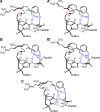Experimental lineage and functional analysis of a remotely directed peptide epoxidation catalyst
- PMID: 24690108
- PMCID: PMC4333582
- DOI: 10.1021/ja410567a
Experimental lineage and functional analysis of a remotely directed peptide epoxidation catalyst
Abstract
We describe mechanistic investigations of a catalyst (1) that leads to selective epoxidation of farnesol at the 6,7-position, remote from the hydroxyl directing group. The experimental lineage of peptide 1 and a number of resin-bound peptide analogues were examined to reveal the importance of four N-terminal residues. We examined the selectivity of truncated analogues to find that a trimer is sufficient to furnish the remote selectivity. Both 1D and 2D (1)H NMR studies were used to determine possible catalyst conformations, culminating in proposed models showing possible interactions of farnesol with a protected Thr side chain and backbone NH. The models were used to rationalize the selectivity of a modified catalyst (17) for the 6,7-position relative to an ether moiety in two related substrates.
Figures







References
-
- Hoveyda A. H.; Evans D. A.; Fu G. C. Chem. Rev. 1993, 93, 1307–1370.
- Rousseau G.; Breit B. Angew. Chem., Int. Ed. 2011, 50, 2450–2494. - PubMed
-
-
For example, see:
- Katsuki T.; Martin V. S. Org. React. 1996, 48, 1–299.
- Zhang W.; Basak A.; Kosugi Y.; Hoshino Y.; Yamamoto H. Angew. Chem., Int. Ed. 2005, 44, 4389–4391. - PubMed
- Malkov A. V.; Czemerys L.; Malyshev D. A. J. Org. Chem. 2009, 74, 3350–3355. - PubMed
- Egami H.; Oguma T.; Katsuki T. J. Am. Chem. Soc. 2010, 132, 5886–5895. - PubMed
-
Publication types
MeSH terms
Substances
Grants and funding
LinkOut - more resources
Full Text Sources
Other Literature Sources

